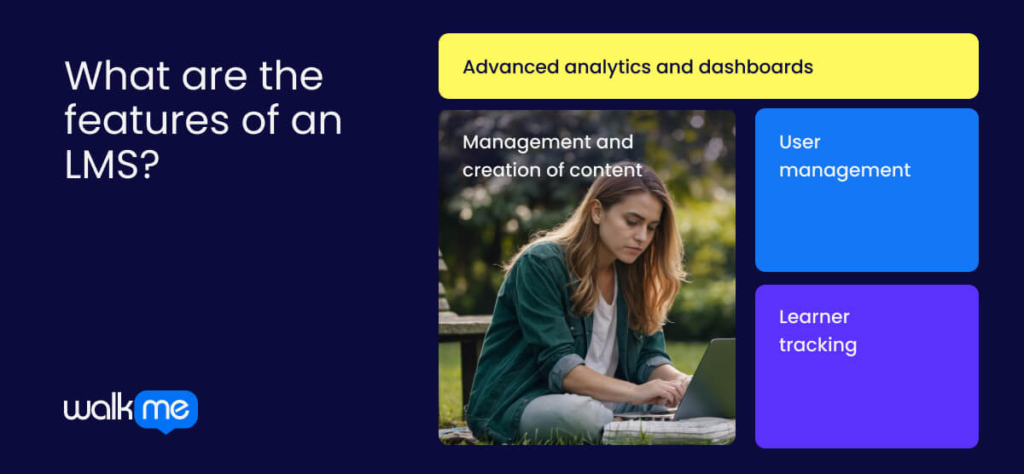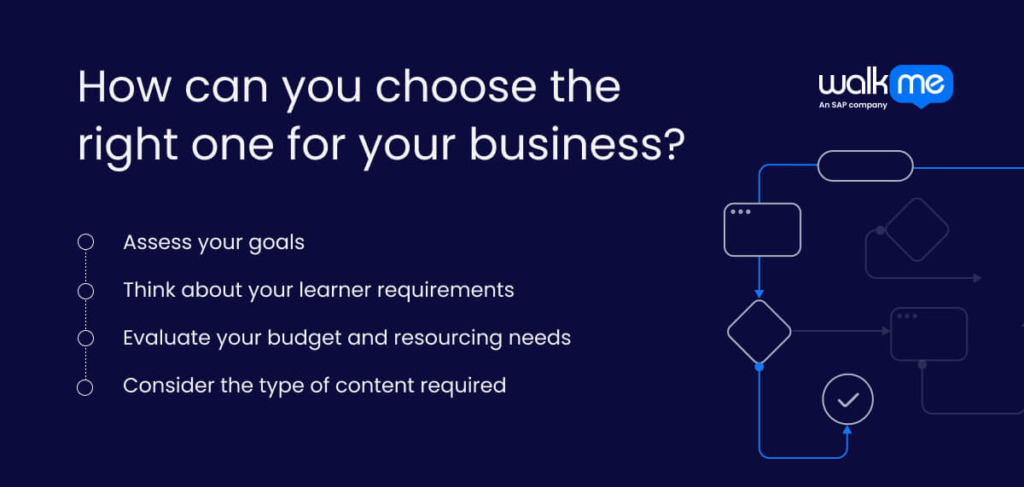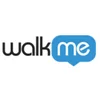A learning platform builds a digital culture aligned with your goals. Choosing the right digital tool is difficult because its features are starting to overlap, blurring the lines between them. An LMS is best for organizing formal, required training, while an LXP excels at delivering personalized, on-demand content from various sources.
The right choice between the two can improve skills and alignment with business objectives. This is vital as research shows 55% of employees want to enhance their performance at work. Understanding their core differences, despite the overlap, is key to choosing the best solution for your team and avoiding a poor return on investment.
In this article, we will cover the differences between an LMS and an LXP so that you can pick the right system for your employees.
What is a learning management system (LMS)?
A Learning Management System, or LMS, is a software platform that helps companies organize and manage their employee training. Your organization can use it to store, share, and track all your learning materials, such as courses and videos.
Using an LMS is a great idea for any organization as it keeps all training in one place. Employees will appreciate the flexibility to learn at their own pace. This approach also saves the company money on travel and printed materials.
An LMS is also perfect for helping your team develop new skills and stay current. Managers can easily track who has completed their courses, which helps monitor progress.
Whether your business is small or a large global corporation, an LMS can be tailored to your needs. Smaller companies can begin with a simple, budget-friendly system and expand later. Larger organizations will need a more robust platform to support thousands of users and integrate with other business software.
What are the features of an LMS?

Knowing the prominent facets of an LMS helps you understand how it supports efficient training delivery and tracking. This type of system is also beneficial for ensuring that mandatory training is completed on time. These are the features that you need to know about:
Advanced analytics and dashboards
Dashboards within an LMS offer a clear, visual summary of all learning activities. You can see and share important details such as course completion rates and quiz scores through reports. Special filters can also help you spot learning trends within different teams.
Management and creation of content
All of your courses, videos, and documents are stored and organized within one location. Simple, built-in tools within the LMS also let you create new content or make quick updates.
User management
You can organize employees into groups based on their job or department within an LMS. A single login makes access simple, while permissions keep data secure. Adding new employees is fast, and the system can automatically assign their onboarding training.
Learner tracking
An employee’s learning journey is tracked from start to finish. Details, including time spent on a course, quiz scores, and completion status, are all recorded within an LMS. Learners also have their own dashboard to see their goals, and automatic reminders help them stay on track.
What is a learning experience platform (LXP)?
A Learning Experience Platform, or LXP, is a type of cloud software for online learning that focuses on the learner. In the first instance, it adopts AI to understand an employee’s skills and interests. Then, it suggests relevant articles, videos, and courses from a wide variety of sources.
This approach puts an employee in charge of their reskilling and upskilling. Instead of just being assigned training, an individual can explore topics, discover new information, and learn at their own pace. The LXP platform is also designed to be engaging and easy to navigate.
A key feature of an LXP is that it’s social. It allows you to connect with coworkers, share what you’ve learned, and create your own content to help others. While your business can adopt a Learning Management System (LMS) for mandatory, corporate e-learning, an LXP is built for personal growth and curiosity. It makes learning a continuous, collaborative, and enjoyable experience.
What are the features of an LXP?
Exploring the features of an LXP can show a business how the tool delivers personalized, and collaborative learning experiences. This type of approach makes learning more flexible and relevant to the user. Here are the elements of an LXP that will interest you:
Content aggregation from multiple sources
An LXP can store all learning materials in one place. Content from websites, videos, and internal company files appears in a single, easy-to-search feed. An employee no longer has to hunt for information in different systems.
Personalized learning paths
Your employees can tailor their learning journeys to their needs. The platform considers their job role, current skills, and career goals to create a unique path. AI suggestions can also recommend what they should learn next.
User-generated content
Employees have the power to create and share their knowledge through an LXP. Simple tools let them upload short videos, how-to guides, or quick tips for their coworkers. Team members can then rate this content, helping the most useful advice stand out.
Social and collaborative learning
Learning becomes a collaborative activity when you get an LXP. Online discussion groups and communities connect employees with coworkers who can share their interests. In these spaces, individuals can also ask questions, share ideas, and get advice from experts.
What are the differences between an LMS and an LXP?
An LMS and an LXP differ in purpose, features, and focus. But both play key roles in learning. Once you understand the role each one plays, you can choose the system that best improves the employee experience.
Take a look at this table to get a better understanding of these two tools:
| LMS | LXP | |
| Goal | The purpose is to manage, track, and deliver formal training programs for a business. | Its goal is to provide a personalized and engaging learning journey that the employee controls. |
| User (s) | The users are administrators who assign and monitor the training, and learners who complete courses. | The users are the employees themselves, who can discover and select their learning materials. |
| Features | Features can include structured course lists, compliance tracking, detailed reports, and set learning paths. | Employees can get features such as AI-driven content suggestions, social learning options, and connections to various content sources. |
| Focus | This tool focuses on formal, required learning and meeting compliance standards. | This platform focuses on informal, ongoing learning and skill development. |
| Best for | This platform is suitable for mandatory compliance training, new employee onboarding, and standard company-wide courses. | This system is suitable for building a culture of continuous learning and supporting individual career growth. |
How can you choose the right one for your business?

Choosing the right learning experience platform (LXP) or learning management system (LMS) is important because it supports your organization’s goals, culture, and learning needs. Picking the wrong system can lead to low engagement and wasted resources.
Here’s what you need to consider before picking the tool for you:
Assess your goals
Your specific goals will help you pick the right platform, whether it is an LMS or an LXP. If you want to deliver compliance training, a system with structured oversight and detailed reporting, such as an LMS is essential.
For people development, a platform focused on personalization and discovery is more suitable. For instance, you may want to encourage employees to learn more about agentic AI in the workplace using an LXP. But whatever they choose to build is up to them! It is also important to decide how you’ll measure success from the start. This could include metrics such as completion rates or how quickly new skills are learned.
Think about your learner requirements
The characteristics of your audience will also influence your choice. For large teams in hands-on roles, an LMS often works best. For instance, a company in retail training employees on a new cash register system would benefit from an LMS that delivers microlearning that can be completed during a break.
For workers in the consulting industry, an LXP is a stronger option. A consulting firm could use an LXP that integrates with its daily communication tools. They could recommend relevant case studies and allow consultants to share insights and learn from each other.
Evaluate your budget and resourcing needs
The total cost of a system includes more than just the license fees. If your budget is tight and your training needs are straightforward, a simple LMS is often more cost-effective. But, if you are making a significant investment in employee development, an LXP might provide better long-term value, even if it costs more upfront. A large, growing company might choose an LXP because it can scale with them and provide access to premium content libraries.
Consider the type of content required
The kind of content you need will also shape your decision. An LMS is built for formal, structured content. A manufacturing company that requires workers to pass a standardized safety exam would use an LMS because it is designed to manage assessments and issue certifications.
But an LXP is ideal for more informal and varied learning. A marketing firm wanting its team to stay on top of the latest trends would use an LXP to pull in content from blogs, podcasts, and industry articles.
Why should you combine an LMS and an LXP?
Your business will benefit from understanding the advantages of combining an LMS and an LXP. This is because it can create a complete learning solution for all types of employee needs. Dive into the benefits of this unified system below:
Improve engagement and personalization
A blended experience makes learning more relevant. The LXP can recommend articles and videos based on an employee’s role and interests, while the LMS handles required training.
For example, a sales team member might discover new selling techniques in the LXP. Following this, they can complete their mandatory technical training in the LMS.
Encourage a balance of informal and formal learning
A better organizational culture encourages the mix of structured courses with casual discovery. The LXP is great for exploring topics and learning from peers, while the LMS provides formal training and assessments.
For instance, a software engineer could use the LXP to learn about a new technology. Once they have done this, they could use the LMS to enroll in a formal certification course.
Compel better insights for continuous skill development
You can combine data from both systems to offer a clearer picture of employee skills. The LXP shows what topics people are curious about, and the LMS tracks their official course completions. If many employees search for a specific skill in the LXP, the company can create a formal training course for it in the LMS.
Develop an all-in-one learning ecosystem
An integrated LMS and LXP system makes everything easier to access. Employees can use a single login to find both informal resources in the LXP and required courses in the LMS. For instance, a banker could watch a helpful video in the LXP and then be automatically enrolled in a related mandatory course in the LMS.
What are the benefits of an LMS?
Learning about the advantages of an LMS will help you assess whether it aligns with your organization’s goals. Without understanding its advantages, you might miss opportunities to enhance training and achieve better results.
These benefits are:
- Stress-free compliance: The process of tracking who has completed required training is much simpler. The system monitors progress and sends reminders, meaning your company meets all legal and industry standards.
- All your training is in one place: Your training materials are all neatly organized in one spot. This system makes it easy for everyone to find what they need. The platform can also automatically handle tasks such as signing people up for courses.
- Saves money and time: Traditional training methods often involve high costs, such as travel expenses, venue rentals, and printed materials. By moving to a centralized, automated system, these costs are reduced or eliminated.
What are the benefits of an LXP?
An LXP allows your business to focus on personalized, engaging, and self-directed learning. This type of tool can improve learner motivation and digital skill building. By understanding its advantages, you can use it to build a better employee training program.
Let’s delve into its benefits:
- Builds a future-ready workforce: An LXP allows the organization to map learning content directly to the skills needed for current and future business goals. By identifying company-wide skill gaps, leadership can strategically guide employees toward necessary competencies.
- Allows you to capture and share internal expertise: Valuable knowledge often exists in the minds of a few key employees. An LXP provides a platform for this expertise to be captured through user-generated videos, guides, and discussion forums. This practice reduces knowledge loss when employees leave and speeds up employee onboarding.
- Initiates data-driven decisions: Instead of guessing what training is effective, an LXP provides analytics on content engagement, skill development, and user activity. This data allows L&D leaders to see which resources provide the most value.
What are the challenges of an LMS?
Every tool has its limitations, and an LMS is no different. By being aware of its issues, you can plan better, and address potential gaps in line with your organization’s needs.
These are the LMS challenges you need to address before they impact your training program:
- Proving its value: LMS platforms can be expensive, and it can be difficult to measure if the training is improving organizational performance. This makes it hard to justify the cost, especially when employees are resistant to change.
- Gaining the interest of your audience: One of the biggest challenges is that many courses are generic and lack engaging content. If the LMS training feels like a chore and doesn’t connect to an employee’s daily work, they will quickly tune out.
- Administering a new system: Managing an LMS can be surprisingly complex behind the scenes. Administrators often face a steep learning curve. For instance, they could spend a good amount of time setting up courses, defining user roles, and pulling reports from interfaces.
What are the challenges of an LXP?
A business needs to know the challenges of an LXP to avoid common problems. For example, an LXP can offer so much content that it becomes overwhelming for learners.
By understanding these issues beforehand, a business can make better choices and ensure the platform truly helps its employees grow.
Here are the challenges you could face when implementing an LXP:
- Keeping content current: LXPs pull in content from many different places, which can create a digital junkyard. Without oversight, the library can fill up with outdated or irrelevant material. It takes a lot of work to keep the content organized, accurate, and useful.
- Personalization can be complex: Effective personalization depends on clean metadata, consistent tagging, and better recommendation models. Without a good data governance and quality plan, engagement drops, and trust erodes.
- Connecting with other tools: An LXP doesn’t work in a bubble. It needs to connect with your company’s other software, such as HR and compliance systems. This data integration can be technically difficult and time-consuming to set up and maintain.
LMS vs LXP: Empowering learners through the right choice
The differences between an LMS and an LXP play a crucial role in shaping an organization’s training strategy. An LMS provides a structured approach to training, focusing on compliance, tracking, and managing learning programs. This type of system is vital for meeting regulatory requirements.
But, an LXP centers on creating engaging, personalized, and self-directed learning experiences. This type of tool encourages continuous development through curated content and social interaction.
A combination of these platforms offers a balanced solution, where the LMS ensures administrative control and compliance, while the LXP drives employee engagement and flexibility.
Before making your choice, you need to look at your organizational needs, such as compliance requirements, scalability, and the importance of engagement. This process will allow businesses to choose the right platform or a blend of both to achieve their learning goals.
FAQs
Examples of LXPs include Axonify, Coursera, and 360Learning. These platforms use AI to suggest personalized learning content. This content comes from many places, like a company’s own courses, as well as outside articles, videos, and other training.
Examples of popular Learning Management Systems (LMS) include SAP Litmos, Docebo, and TalentLMS. An LMS helps organizations manage learning by creating, organizing, and delivering courses. It tracks learner progress, ensures compliance, and provides reports to measure training effectiveness.
Google Classroom is an LMS that helps teachers organize and share lessons and assignments. It acts as a central place where teachers can create, distribute, and grade assignments, communicate with students, and manage their work within a school system.

